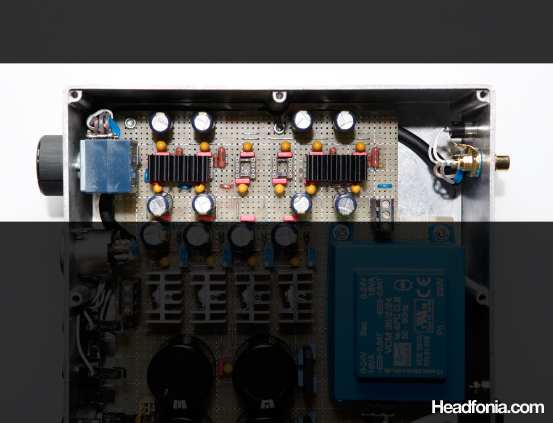My friend Bram aka Earfonia started tinkering with a design for a very simple balanced amplifier. Somehow in the process, he decided to switch gears to make a Pseudo Balanced Amplifier. Four amplifier channels for one headphone (two for right channel, two for left channel), but fed from a standard unbalanced stereo signal at the input. The simplicity of the design and the low cost of the parts makes the PBA the most affordable balanced amplifier we have seen so far. So affordable that the PBA can also stand for the “Poor-man’s Balanced Amplifier”.
The amplifier section is probably the simplest design I have ever seen for a headphone amp, consisting of a simple one op-amp based amplification per channel. All the op-amps are set at a fairly high gain of 13 for maximum sonic quality. The power supply is pretty robust, with a dual secondary 24VAC output into an LM317 and LM337 regulations for a rail voltage of +/-28VDC (Bram said that the LM317/337 regulators are better regulators than the usual LM78XX). The left channel and right channel power supply regulations are completely separated to make a dual mono power supply. Finally, the amplifier is DC coupled, so no capacitors in the signal path. The op-amp used for the amplifier section is the OPA552, chosen for their high maximum current capability (200mA).
The build uses a simple but sturdy and thick aluminum enclosure. The layout is very clean and organized. Every connection point is very secure, and the amplifier is a joy to use. Bram even provided three different output paths in the form of two 1/4″ outputs and one 4-pin XLR balanced output. The output are configured as follows:
- Left 1/4″: Single ended with passive ground (2 channel)
- Center 1/4″: Single ended with active ground (3 channels)
- Right 4-pin XLR: Balanced output (4 channels)
The sound reminds me of a warm, smooth sounding CMOY with far more spacious soundstage, frequency extension and ambiance. I don’t think I’m totally into the OPA552’s sound signature, though I understand that it is chosen for its high current capability. It has a harsh lower treble that gets in the way of the smooth midrange and lower end.
The amplifier started as an inquiry to see how much improvement you get from an active ground and balanced topology, when compared to a regular single ended amplifier. For that, the three different outputs on the PBA will allow you to see if indeed there is any difference between those topologies. So, not only does the PBA gives you the most affordable balanced amplifier in the market, as a bonus you also get to test out the differences between a 2 channel, 3 channel, and 4 channels amp. I went ahead and did the comparison, and this is what I found:
- 2 channels: basic sound. decent enough
- 3 channels: improved dynamic range, frequency extension, and soundstage
- 4 channels: further improved dynamic range, frequency extension, and soundstage
Between the different topologies, the tonality of the sound remains the same.
The magic begins when I plugged in the Hifiman HE-6 into the 4-pin XLR jack. Smooth sound all around, and especially in the midrange section. And most of all, this amp actually has what it takes to drive the HE-6 with plenty of authority, though still a tad below the speaker amps.
I wonder if he will build another one for me. More information and schematics of the amps can be found below.

And this is the amplifier section. One op-amps for each channel, with a heatsink on each pairs of op-amps. Just beautiful.

Very spartan enclosure, yet provides three different types of outputs: 2 channels (1/4" TRS), 3 channels active ground (1/4" TRS), and 4 channels (XLR).















Earfonia
Thanks for the article Mike!
I hope we can have more experience with PBA topology, with different chip or amp circuit on the amp channel, to know more about the advantage and disadvantage of the PBA topology 🙂
Anonymous
You want me to build an LM3875 PBA right? 🙂
I’m still struggling with finding a good enclosure for it, so the project has been put on hold. I plan to build the LM3875 fitted with a good DAC on the same chassis, to further minimize signal path and eliminate interconnects altogether. I’ve already gotten a donor, the simple HRT MS2, but still thinking/designing how to case everything together.
Earfonia
Ah, that’s sounds interesting Mike! Hope you can fit them altogether 😀
CccC
What? Only one comment? That’s blasphemy! 😛
Earfonia
Ha..ha.. 🙂
Don’t worry new concept, not many people familiar with it :p
Thanks!
Anonymous
Everyone is puzzled as how a simple cmoy-like design can drive the HE-6 with authority. 🙂
yoav tzfati
Hey, nice review!
Will it be hard to make the PBA work from a balanced input?
Also how does it compare to the JDS labs cmoy (when not driving orthos)?
Thanks!
Anonymous
Yes, I think Bram was having problems with balanced input (I don’t
remember what it was), and so he decided to make this as a pseudo
balanced. I don’t think you should worry too much about not having
unbalanced inputs, aside from the fact that you can’t brag that your
system is “fully balanced” from signal to end. 🙂
The JDS Labs is surprisingly smoother sounding, but I think this is due
to the op-amp choice of the PBA. The PBA is better technically, more
spacious and clearer separation, and if I have the same opamp that I use
on the JDSLabs installed on the PBA, the PBA would probably be just as
smooth.
Earfonia
Hi, sorry for late reply 🙂
PBA can easily modified to take balanced input. Just connect the 2 ground channels to the cold / inverted input signal, that’s all 🙂
What Mike mentioned, I was struggling to create a balanced output using unbalanced input 🙂
Anonymous
Thanks for the clarification, Bram.